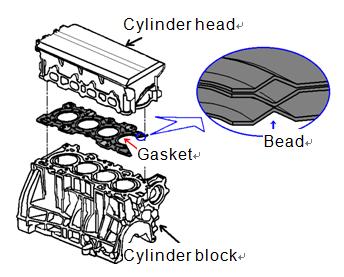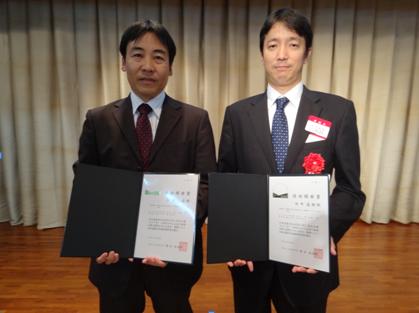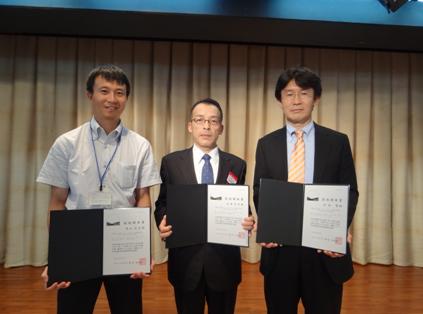Sumitomo Metals Receives Two Awards from Japan Institute of Metals
for development of new non-leaded free cutting steel and
high fatigue-resistant steel sheet
November 9, 2011
- Sumitomo Metal Industries, Ltd.
- Sumitomo Metals (Kokura), Ltd.
- Sumitomo Metals (Naoetsu), Ltd.
On November 8, 2011, Sumitomo Metal Industries, Ltd. (Sumitomo Metals), Sumitomo Metals (Kokura), Ltd. (Sumikin Kokura), and Sumitomo Metals (Naoetsu), Ltd. (Sumikin Naoetsu) received the 34th Technical Development Award from the Japan Institute of Metals*1 for the following two accomplishments:
1. Development of low-carbon non-leaded free cutting steel “Smigreen CS”
2. Development of fine-precipiatates dispersed stainless steel sheet “NAR-301L HSX”
Smigreen CS received the award jointly with Osaka University, while NAR-301L HSX received the award with Honda R&D Co., Ltd. and Nippon Leakless Corporation. Sumitomo Metals and Sumikin Naoetsu won awards for the fourth consecutive year for their joint developments.
<Details of Award>
1. Development of “Smigreen CS,” low-carbon non-leaded free cutting steel that is easy to machine (Sumitomo Metals, Sumikin Kokura, and Osaka University)
Cutting steel has superior properties, such as: (1) it enables precision cutting work in terms of measurement and surface roughness; (2) it reduces wear on the edges of cutting tools; and (3) it reduces the burden on advanced and automated working processes, as chip forms are constant and predictable when machined. Conventionally, such properties are obtained by adding lead or other metals to steel. However, as lead is an environmentally hazardous material, non-leaded free cutting steel has been demanded.
Sumitomo Metals (Kokura) and Sumitomo Metals have succeeded in developing easy-to-machine, non-leaded free cutting steel Smigreen. The research included analyzing the cutting mechanism, namely, how compounds in steel function during cutting processes. In addition to being easy to cut, Sumitomo’s free cutting steel is unique in terms of being provided in a series of products that match the machinability of different components. These include steel that optimizes the configuration of manganese sulfide*2 and steel that has an environmentally-friendly special element added. A wide variety of products in the Smigreen Series has been highly valued by customers in many industries.
Smigreen CS is non-leaded free cutting steel with the addition of more sulfur compounds.
2. Development of “NAR-301L HSX”, fine precipitates dispersed stainless steel sheet for high combustion-pressure cylinder head gaskets (Sumitomo Metals, Sumikin Naoetsu, Honda R&D Co., Ltd., and Nippon Leakless Corporation)
The cylinder head gasket is a sealing component that sits between the cylinder head and the cylinder block in an engine to avoid leakage of combustion gas. The explosive combustion of gasoline in the engine makes the cylinder head to float slightly by pressure and causes combustion gas to leak. This leak can be prevented by the gasket which is made of stuck thin steel sheets and has the wave shaped portions called beads (see the illustration below). The bead, with its spring-like elastic force, prevents the leakage. Thus, the gasket is required to be made of materials with fatigue strength and corrosion resistance to withstand repeated movements of the cylinder head. High-strength stainless steel is commonly used for gaskets.
In recent years, with the aim of improving fuel efficiency and reducing emissions of CO2 gas and pollutants as a way to reduce environmental burden, engines have become lighter and their combustion pressures have increased. These measures have resulted in intensifying floating of the cylinder head at the time of combustion. Consequently, the cylinder head gasket needs to have higher spring performance and superior fatigue-resistance characteristics against repeated load burden.
Based on NAR-301L HS1, which received the Technical Development Award in fiscal 2008, the Sumitomo Metals Group has developed NAR-301L HSX by creating even finer grains on the surface of the steel sheet and utilizing the change in metallic characteristics caused by bead-forming processing (age hardening*3). The new material’s characteristics are as follows:
1) The fine grains on the sheet surface have become finer as a result of precipitating a fine chrome-nitrogen compound by using annealing and heat treatment processes.
2) Thanks to age hardening resulting from the heat treatment at the time of processing steel sheet into gaskets, the new material has become stronger without any increase in the number of manufacturing processes, and has improved combustion gas sealing performance by 30%.
NAR-301L HSX has been adopted in the Honda Accord Diesel for the European market since fiscal 2008 and has been contributing to the environmental preservation movement through an increase in diesel engine cars.

<Winners>
・Development of low-carbon non-leaded free cutting steel “Smigreen CS”
Naoki Matsui (Sumitomo Metal Industries, Ltd.)
Atsushi Okayama (Sumitomo Metal Industries, Ltd.)
Toru Kato (Sumitomo Metal Industries, Ltd.)
Tetsuya Hasegawa (Sumitomo Metals (Kokura), Ltd.)
Mr. Junsuke Fujiwara (Osaka University)

・Development of fine-precipiatates dispersed stainless steel sheet “NAR-301L HSX”
Kazuhiko Adachi (Sumitomo Metal Industries, Ltd.)
Masaru Abe (Sumitomo Metals (Naoetsu), Ltd.)
Mr. Takashi Katsurai (Honda R&D Americas, Inc.)
Mr. Tadao Nishiyama (Honda R&D Co., Ltd.)
Mr. Hiromitsu Sasaki (Nippon Leakless Corporation)

<Notes>
| *1 | The Japan Institute of Metals was founded as a non-profit public organization in 1937 with the primary objective of promotion and development of science, technology and industry of metals and materials. It publishes monthly periodicals of technical papers and holds symposiums and seminars. The Technical Development Award is given to engineers who have achieved original creative technical development in metal engineering as well as new technologies or new products that are related. |
| *2 | Manganese sulfide is the compound of the sulfur and manganese which are contained to improve the machinability of steel materials |
| *3 | Age hardening is designed to increase the strength of metal material by a heat treatment technique, the hardening effect of which appears with a time delay when the material cools down. The metal material changes its crystalline structure when time passes and obtains more strength than the original material. |
